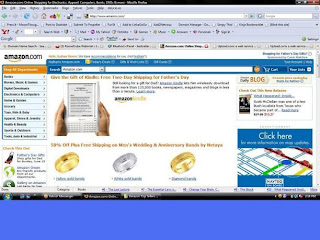
Amazon.com, Inc. is an American e-commerce company. Its global headquarters is located in Seattle, Washington.
Amazon has used the internet to create a truly global business platform, one which is poised for incredible growth in the coming decade. The question in many investors' minds these days is how profitable that business can be. Sales have surged in the last year at the world's largest e-commerce company, growing 39% from a combination of low prices, shipping promotions, and rollouts of new product categories. For e-commerce usability, Amazon.com used to be the model. In 2001, we evaluated the usability of twenty e-commerce sites and Amazon was the clear winner, scoring 65% higher than the average of the other nineteen sites. Having the Web's best usability served Amazon well: sales increased by 126% from 2001 to 2004.
While most people naturally think of Amazon as the internet superstore that sells products in over forty categories, from books to electronics to groceries to jewelry to auto parts, the company has gradually expanded beyond that simple business platform; today Amazon is simultaneously an ecommerce and internet technology platform, a fulfillment and logistics platform, a search technology, an internet advertising platform, and even an internet startup incubator of sorts.
Founded in 1995 by Jeff Bezos as an online bookstore, Amazon has since greatly expanded its business. Today, Amazon’s stated mission is to be a place where “people can come to find and discover anything they might want to buy online.” Its key pillars of lowering price, offering convenience, expanding selection, and increasing availability are interrelated in what the company calls a virtuous cycle, and together make up the foundation of the fabulous growth that has taken Amazon from a bookstore started in a garage to a $14B retail machine. Amazon’s direct-to-consumer online model allows it to keep its inventory in a small number of strategically located large warehouses, letting the company offer a vast selection of goods and without the capital investment and inventory risk that traditional brick and mortar retailers face.
In addition, due to sophisticated inventory forecasting, fast inventory turns, and overall operational efficiency, Amazon has managed to build a retail business with a negative operating cashflow cycle, which means Amazon gets paid for products by customers before they have to pay their suppliers for the goods. Working capital has effectively become a source of investment cash for the company.


What's Still Good About Amazon
Confirmation email. Except when they're part of a co-branded sale, Amazon's use of confirmation emails keeps users in the loop and increases their trust in the overall fulfillment process. Fulfillment. When you buy something, you get it. In the rare case that there is a problem, you get a clear email telling you so. Of course, that's the way e-commerce should be, but all too often it's not when you shop on other sites. Amazon's success with fulfillment clearly proves that the total user experience goes beyond the user interface.
Login screen. Amazon's sign-in screen remains a model to be emulated, minimizing the common problem of new customers who try to log in without having registered. Amazon presents two questions in linear order: (1) "What is your email address?" and (2) "Do you have an Amazon.com password?" For the second question, users can select one of two radio buttons: "No, I am a new customer," or "Yes, I have a password." Many other sites present the new- and established-user sections side-by-side, and thereby divert new users to the established-user section through the magnetic attraction of type-in fields.
Relevant cross-sales. "Customers who bought this book also bought" continues to be a stellar approach to cross-selling. It almost always drags up other relevant products that the customer is likely to want.
Sample content. One of the biggest challenges in e-commerce is alleviating people's fear of getting either the wrong product or a low-quality one. Online sales have a huge handicap here, because shoppers can't touch the merchandise. To minimize this problem, get users as close to your products as possible in a virtual world. Give them the specifics they need in a language they understand and show them meaningful pictures. Amazon does this well, especially in using sample content, such as book excerpts and music snippets.
Comprehensive product selection. Amazon lays claim to "earth's biggest selection" and for once, a company actually lives up to its slogan. We've known since 1997 that users want comprehensive services on the Web, and Amazon fulfills that need, especially within their original focus of books. If it's published, they carry it. Even better, they don't remove a book from the site once it goes out of print; instead, they offer a marketplace for buying and selling used copies. The product page retains the same URL, even when the product status changes, thus avoiding the linkrot that plagues so many other retailers.








No comments:
Post a Comment